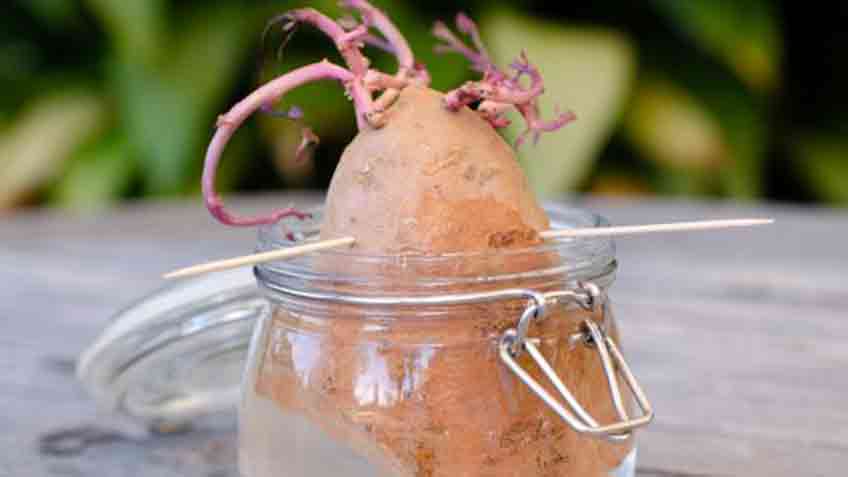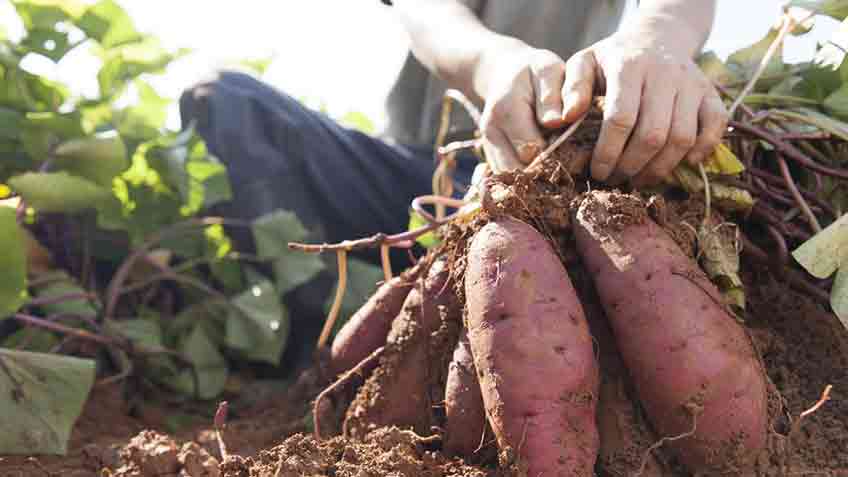Unlike most vegetables and fruits, sweet potatoes are sprouted from slips rather than seeds! This is something that makes their production process incredible and fun for gardeners. Slips are shoots grown from a sturdy sweet potato. Once they are sprouted, you can shift them inside the container for further production steps.
Sweet potatoes are found in two distinct types known as vining and bush types. While discussing their sprout conditions, both varieties can be grown in hot summer conditions, rich soil, and proper spacing. However, the process of sprouting slips from a sweet potato can be challenging for beginners; hence, to minimize this hassle, you have come up with a detailed guide to ensure impeccable sprouting for your sweet potato harvest. So let’s get into it!
How To Sprout Sweet Potatoes For Planting
Assuming you need to develop consumable tubers, it will take approximately 100 to 140 days, depending on your growing type. Sweet potatoes are broadly ready to move as little compartment plants in the spring. However, they are likewise simple to develop yourself by growing “slips” from bits of the tubers.
Start Slip From Your Sweet Potato

As discussed above, sweet potatoes are derived from slips; to acquire slips for production, you can use multiple ways. For example, it can be ordered through online platforms, or you can directly purchase a sweet potato from a supermarket or one from your garden. Whether you will pick them from a market or your garden, make sure to identify the type.
To begin your slips, you would require some mature and clean sweet potatoes. Each sweet potato will help you acquire 50 slip sprouts. To make sprouts, cautiously wash your potatoes and cut them down the middle or more significant sections. Spot each segment in a container or glass of water with half of the potato underneath the water and half above. Use toothpicks to hold the potato upward. Try to put them where there is heat and sun radiation. Within a couple of days, you will see leafy sprouts all over them.
Place Sprout Into A Bowl
When your sprouts have grown, you need to isolate them into plantable slips. To do this, you take each sprout cautiously and twist the lower part to separate them from the sweet potato. Next, lay each sprout in a shallow bowl with the base portion of the stem lowered in the water. In contrast, leaves looming over the edge of the bowl.
After a few days, roots will rise out of the lower part of each new plant. This ensures that your newly sprouted plant is ready to be planted. To keep your slips sound, it is recommended to change the old water with fresh and dispose of any slip that isn’t delivering roots or resembles its withering.
Get Your Soil Ready For Slip

Once you have successfully developed roots from your sprouts, the next step that one should uphold before planting is soil preparation; when it comes to planting sweet potatoes, you need well-drained and loose soil to grow large tubers at the end. Loose and well-drained soil will help the roots to expand as much as they want. When it comes to sweet potatoes, loose soil is among the most important factors to consider.
It’s Time To Plant Your Slip
Plant sneaks through pre-arranged soil with the roots pointing down. When planting the slip inside the soil, point the bottom half covered whereas the top half with leaves. While pouring the soil, be careful not to wound the new plant. Sweet potatoes don’t like to be injured or knock around something over the top. Tenderly press the encompassing soil to set the plant and to eliminate any excess air pockets. Proceed the same way until each of your slips is planted.
Give It Water
After carefully placing all of the slips, ensure they have the precise water supply. You’ll have to give them a profound dousing until all of the encompassing soil is wet. You are advised to water the newly planted slip every day for at least one week. After that, you can skip a day for next week.
If the ground is parched or you’ve had a ton of downpour, you might have to change this watering schedule as per your garden’s demographics. If you face drought in your region, you don’t need to worry about it as sweet potatoes can survive when there is a dry spell, but their production may reduce. Make sure to fetch them a precise water supply to minimize the impact of drought over yield.
Harvest Grown Sweet Potatoes

To find out the right time for harvesting sweet potatoes, you need first to comprehend the type of sweet potatoes you have planted. If you have bought your slips from the market, then read out the information given on the packaging. Generally, it takes 90 to 120 days for most of the sweet potato varieties to grow fully. Some types grow quickly in the northern regions of the USA, whereas some in southern regions require little extra time. Therefore, whether you live in northern or southern areas, we suggest harvesting your sweet potatoes crop earlier than the frost period.
Store Your Harvested Sweet Potatoes

Once you are done with harvesting, now it’s time to store them subtly for better usage. Before storing them in a box, you should let them soak in the open air. Then, store them into a box and keep those boxes with enough air circulation for a few weeks. Make sure to dry them off at a temperature of about 85 to 90 degrees Celsius. After a few weeks, you can shift them to a place where there is a cold temperature between 50 to 60 degrees Celsius. Then, with proper care, you can store them for several months.
Frequently Asked Questions
How to grow sweet potatoes?
Growing sweet potatoes in not a cup of tea. You need to get the sweet potato sprout inside a jar before planting. Once the slip is ready now prepare the soil and plant it carefully.
How to sprout sweet potatoes?
Cut sweet potatoes in a cone shape from its bottom. Now take a jar and fill half of its area with water. Place your pared sweet potato into this jar as half of your sweet potatoes should be inside the water. It will start sproutings from its top within a few days.
Can I grow the entire sprouted sweet potato inside the soil?
No, this is not the right way to plant sweet potatoes. You should better wait until the roots have developed slips. Remove those grown slips and plant them carefully.
Wrap Up
Despite being versatile in nature and taste yet sweet potatoes require additional care and professional guidance to lift a successful harvest. Our guide covers each facet that will help you raise a healthy yield to sell, cook and use for unlimited purposes.

